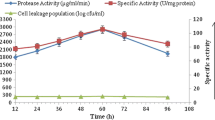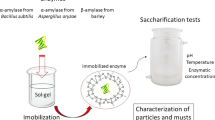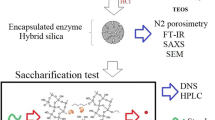Abstract
Starch degrading enzymes, viz., β-amylase, glucoamylase, and pullulanase, were purified using magnetite-alginate beads. In each case, the enzyme activity was eluted by using 1.0 M maltose. β-Amylase (sweet potato), glucoamylase (Aspergillus niger), and pullulanase (Bacillus acidopullulyticus) from their crude preparations were purified 37-, 31-, and 49-fold with 86, 87, and 95% activity recovery, respectively.
Sodium dodecyl sulfate-polyacrylamide gel electrophoresis analysis showed single band in each case.
Similar content being viewed by others
References
Worlock, A. J., Sidgwick, A., Horsburgh, T., and Bell, P. R. L. (1991) The use of paramagnetic beads for the detection of major histocompatibility complex class I & Class II antigens. Biotechniques 10, 310–315.
Karlsson, G. B. and Platt, F. M. (1991) Analysis and isolation of human transferrin receptor using the OKT-9 monoclonal antibody covalently crosslinked to magnetic beads. Anal. Biochem. 199, 219–222.
Raghavarao, K. S., Dueser, M., and Todd, P. (2000) Multistage magnetic and electrophoretic extraction of cells, particles and macromolecules. Adv. Biochem. Eng. Biotechnol. 68, 139–190.
Safarik, I. and Safarikova, M. (1999) The use of magnetic techniques for the isolation of cells. J. Chromatogr. B. 722, 33–53.
Safarik, I. and Safarikova, M. (1997) Overview of magnetic separations used in biochemical and biotechnological applications, in Scientific and Clinical Applications of Magnetic Carriers (Hafeli, U., Schut, W., Teller, J., and Dorowski, M., eds.), Plenum Press, New York, pp. 323–340.
Tyagi, R. and Gupta, M.N. (1995) Purification and immobilization of Aspergillus niger on magnetic latex beads. Biocatal. Biotrans. 12, 293–298.
Teotia, S. and Gupta, M. N. (2001) Purification of α-amylases using magnetic alginate beads. Appl. Biochem. Biotechnol. 90, 211–220.
Teotia, S., Khare, S. K., and Gupta, M. N. (2001) An efficient purification process for sweet potato beta-amylase by affinity precipitation with alginate. Enzyme Microb. Technol. 28, 792–795.
Sharma, S., Sharma, A., and Gupta, M. N. (2000) One step purification of peanut phospholipase D by precipitation with alginate. Bioseparation 9, 93–98.
Smidsrod, O. and Skjak-Braek, G. (1990) Alginate as immobilization matrix for cells. Trends Biotechnol. 8, 71–78.
Burns, M. A., Kvesitadze, G. I., and Graves, D. J. (1985) Dried calcium alginate/magnetite spheres: A new support for chromatographic separations and enzyme immobilization. Biotechnol. Bioeng. 27, 137–145.
Bernfeld, P. (1955) Amylases α and β, in Methods in Enzymology, Vol. 1 (Colowick, S. P. and Kaplan, N., eds), Academic Press, New York, pp. 149–158.
Nelson, N. (1944) Photometric adaptation of the Somogyi method for the determination of glucose. J. Biol. Chem. 153, 375–380.
Bradford, M. M. (1976) A rapid and sensitive method for the quantitation of microgram quantities of protein utilizing the principle of protein-dye binding. Anal. Biochem. 72, 248–254.
Hames, B. D. (1986) An Introduction to polyacrylamide gel electrophoresis, in Gel Electrophoresis of Protein; A Practical Approach, (Hames, B. D. and Rickwood, D. eds), IRL Press, Oxford, pp. 1–86.
Cudney, R. and McPherson (1993) A Preliminary crystallographic analysis of sweet potato β-amylase. J. Mol. Biol. 229, 253–254.
Manjunath, P. and Raghavendra Roa, M. R. (1979) Comparative studies on glucoamylases from three sources. J. Biosci. 1, 409–425.
Vihinen, M. and Mantsala, P. (1989) Microbial amylolytic enzymes. Crit. Rev. Biochem. Mol. Biol. 24, 329–418.
Crab, W. D., Mitchinson, C. (1997) Enzymes involved in the processing of starch to sugars. Trends Biotechnol. 15, 349–352.
Janse, B. J., Pretorius, I. S. (1995) One-step hydrolysis of starch using a recombinant strain of Saccharomyces cerevisiae producing alpha-amylase, gluco-amylase and pullulanase. Appl. Microbiol. Biotechnol. 42(6), 878–883.
Patil, V. B., Patil, N. B. (2000) Biomass conversion: Synergistic use of α-amylase and amyloglucosidase for rapid and maximum conversion of starch into glucose. Ind. J. Chem. Technol. 7, 47–50.
Author information
Authors and Affiliations
Corresponding author
Rights and permissions
About this article
Cite this article
Teotia, S., Gupta, M.N. Magnetite-alginate beads for purification of some starch degrading enzymes. Mol Biotechnol 20, 231–237 (2002). https://doi.org/10.1385/MB:20:3:231
Issue Date:
DOI: https://doi.org/10.1385/MB:20:3:231




